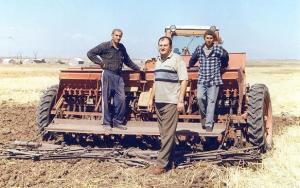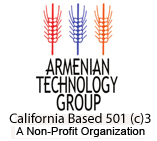Nor Gyank -- Wheat Farmer Leads ATG Shirak Projects
September 25, 2004

For additional photos related to this article, visit the ATG Photo Gallery.
Nor Gyank, Province of Shirak, Armenia — In an open, cultivated field just outside the village of Nor Gyank, Araik Sukiasyan and tractor driver Artyom Petrosyan checked the depth of newly-sown wheat seed, as the driver’s son looked on. Satisfied the seed was reaching the proper depth, the two men continued their work. In the distance, towards the town of Artik, the domes of Haridj Monastery were framed by the rolling hills above Haridj village. Still further, the snowy peaks of Mt. Aragadz loomed against the blue sky. “A farmer has to be honest with the land,” Sukiasyan said. “You can’t deceive soil. What you give the soil, it gives back….”
Wheat, alfalfa, and potato farmer Araik Sukiasyan, also the mayor of Nor Gyank (means “new life” in Armenian), has farmed here his entire life. “Since 1917, when my grandparents came from Alashkert, near Moush in Old Armenia, my family has lived and worked in Nor Gyank,” he said. “My grandfather, whose name was Sukias, loved his new home. When he died, we changed our family name to Sukiasyan in his honor.”
During the Soviet era, Sukiasyan and other farmers in Nor Gyank cultivated the land for large government collective farms, known in Russian as kholkhoz. Grain farmers were guaranteed steady supplies of seed, fuel, and fertilizer. Irrigation water came from a reservoir located in nearby Artik. “After the Soviet collapse, all this ended,” Sukiasyan said. “Seed deliveries were sporadic, and sometimes, due to problems at the border, we received none at all.” Due to a lack of funds, the dam near Artik soon became inoperable, leaving the fields to depend entirely on rain. “All at once, our situation became dire, with no help in sight,” he said.
New relationship rejuvenates area farming
In 1994, professionals from the Armenian Technology Group (ATG), an organization dedicated to strengthening the rural economy of Armenia, began working with farmers in the region of Artik, including Nor Gyank and the neighboring villages of Meghrashen, Vardakar, and Arevshat. Seminars were held in Artik and Gyumri, where new techniques in wheat production were presented. Experiments were conducted with new varieties, including Blizzard, Weston, and W301.
Several of the varieties offered by ATG proved quite successful in the fields of Nor Gyank. “Yields had dropped to one metric ton per hectare, sometimes even less,” Sukiasyan said. “From the first year working with ATG, we harvested three to four metric tons per hectare.” As a program farmer, Sukiasyan obtained seed from ATG, and then repaid the organization after harvest. “I gave seed to farmers under the same principle,” he said. “Neighboring farmers, seeing the high yields from the new varieties provided by ATG, began purchasing seed from my fields. Now, several farmers in Nor Gyank are growing these varieties.”
Last year, Sukiasyan planted Weston, W301, Bezostaya, and Dadash. “The harvests were good, especially with Weston and Dadash, which yielded 5.2 metric tons,” he said. Dadash, a variety ATG obtained from CIMMYT (International Wheat and Maize Improvement Center), an organization based in México that develops new varieties and offers them to countries around the world, has adapted quite well to the rain-fed fields of Nor Gyank. “Dadash is resistant to the dry conditions of our area,” Sukiasyan said. “We know we can count on ATG to provide our farmers with the best varieties available.”
New programs increase stability
In Armenia, a weak market for high quality wheat seed has forced farmers to sell first generation seed at low prices or even to flour mills, which normally purchase fourth or fifth generation seed to make flour. Also, without the availability of proper credit, farmers are compelled to sow lesser quality seed, resulting in lower yields and wheat less resistant to diseases such as rust and mrrig. Collaborating with ATG’s Yerevan office, wheat producers in the Artik region and farmers in the provinces of Lori, Ararat, and Syunik have formed an association of seed producers to advance the cooperation of Armenia’s wheat farmers.
Founded in 1998, the Seed Producers’ Support Association (SPSA) has become the focal point of ATG’s well-known Wheat Seed Project, with the purpose of strengthening the bargaining position of wheat farmers. Araik Sukiasyan, noted in the region as a responsible farmer who consistently produces high quality seed, was elected president of SPSA in 2002.
According to Sukiasyan, the purpose of SPSA is two-fold: “By forming an association like SPSA,” he said, “farmers will be able to work together to sell their seed at a good price. Secondly, by setting up credit unions for SPSA growers, funds will be available for farmers to purchase seed, fertilizer, and herbicide in a timely manner, to ensure the highest yields and the best seed possible.” The credit unions, which came into existence after a study was made of the American system, promise tremendous benefits for SPSA farmers. “We are helping good farmers produce good seed,” Sukiasyan stressed.
Currently, on small plots in different wheat-producing regions across Armenia, SPSA growers are experimenting with 23 new varieties of wheat, to learn which varieties are suitable for Armenia’s varied climates and growing conditions. On a 23-square-meter plot near his home, Sukiasyan planted 21 varieties of winter wheat. “After the snow melts next spring, I will plant two varieties of spring wheat,” he said. “We will carefully study each variety, to be sure which are best suited for fields in Nor Gyank and the Artik region.”
New energy, ideas boost village economy
Since the dark years following the break-up of the Soviet Union, farmers in Nor Gyank and in other remote regions of Armenia have been making tremendous strides towards self-sufficiency and establishing themselves in a modern market economy. In the high mountain village of Nor Gyank, Sukiasyan has served as mayor since 1987, striving to better the community and strengthen the area’s farming economy. “I have worked closely with local farmers and our friends at ATG,” he said. “We keep in close contact, which helps our projects run smoothly.”
Recently, an SPSA grower from Nor Gyank sold five metric tons of wheat seed to farmers in Arzakan, in the Kotayk province. “It was a great scene,” Sukiasyan said. “Farmers who hadn’t ordered any seed were so impressed with the quality of what they saw, they placed an additional order for two metric tons of seed. This all came about through our collaboration with ATG agronomists, who had informed the growers in Arzakan about our product.”
As president of SPSA, Sukiasyan is working for the independence of Armenia’s wheat farmers. “My dream is for Armenia’s farmers to produce enough wheat for our country. That is our purpose, our strategy, to have Armenia independent in its need for wheat. Then, we will produce enough to export to other countries. This was the dream of ATG’s founder, Art Hazarabedian. A man who truly worked for our farmers, our families.”
On a hill overlooking Nor Gyank, ruins of a fortress and cemetery stand as testimony to the region’s ancient past. “The fortress dates from the times of the Urartean kings,” Sukiasyan said. A seventh century church located at the center of the village serves as a place of pilgrimage for area residents. “The church was built by King Gagik, from the Bagratuni family who later ruled Ani,” he said. “One day, we hope to renovate the church.” Sukiasyan smiled. “We have to live here, and cultivate this land,” he said. “It is the land of our ancestors.”
For more information about how you can help Armenia’s farmers, contact the ATG office at (559) 224-1000 or by e-mail (info@atgusa.org). Tax-deductible donations can be sent to ATG; 1300 E. Shaw, Suite 149; P.O.Box 5969; Fresno, CA 93755-5969.
You may also donate to ATG online.

Follow Us